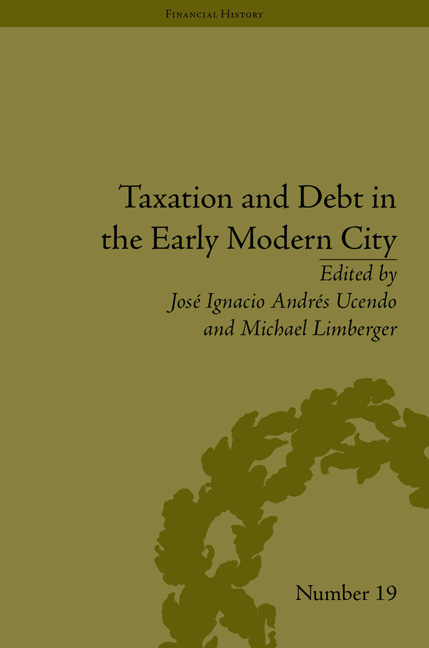Book contents
- Frontmatter
- CONTENTS
- Acknowledgements
- List of Contributors
- List of Figures and Tables
- Introduction
- 1 From Private to Public Management: Tax Farming and Customs Duties in Rome (1630–1700)
- 2 From Taxation to Indebtedness: The Urban Fiscal System of Milan during the Austrias Domination (1535–1706)
- 3 The Urban Tax System in the Kingdom of Naples (Seventeenth to Eighteenth Centuries)
- 4 Public Institutions, Local Politics and Urban Taxation in Seventeenth-Century Aragon
- 5 Taxation and Debt in the Early Modern Castilian Cities: The Case of Seventeenth-Century Madrid
- 6 Tax Collection in Spain in the Eighteenth Century: The Case of the ‘Décima’
- 7 Finances, the State and the Cities in France in the Eighteenth Century
- 8 The Making of the Urban Fiscal System of Antwerp until 1800: Excises, Annuities and Debt Management
- 9 The Dutch Financial System between Public and Private Interests: Urban Debt (1500–1700)
- 10 The Urban Fiscal System in the Habsburg Monarchy: The Case of the Austrian Hereditary Lands in the Sixteenth to Eighteenth Centuries
- 11 Taxation and Debt in Early Modern German Cities
- Notes
- Works Cited
- Index
6 - Tax Collection in Spain in the Eighteenth Century: The Case of the ‘Décima’
- Frontmatter
- CONTENTS
- Acknowledgements
- List of Contributors
- List of Figures and Tables
- Introduction
- 1 From Private to Public Management: Tax Farming and Customs Duties in Rome (1630–1700)
- 2 From Taxation to Indebtedness: The Urban Fiscal System of Milan during the Austrias Domination (1535–1706)
- 3 The Urban Tax System in the Kingdom of Naples (Seventeenth to Eighteenth Centuries)
- 4 Public Institutions, Local Politics and Urban Taxation in Seventeenth-Century Aragon
- 5 Taxation and Debt in the Early Modern Castilian Cities: The Case of Seventeenth-Century Madrid
- 6 Tax Collection in Spain in the Eighteenth Century: The Case of the ‘Décima’
- 7 Finances, the State and the Cities in France in the Eighteenth Century
- 8 The Making of the Urban Fiscal System of Antwerp until 1800: Excises, Annuities and Debt Management
- 9 The Dutch Financial System between Public and Private Interests: Urban Debt (1500–1700)
- 10 The Urban Fiscal System in the Habsburg Monarchy: The Case of the Austrian Hereditary Lands in the Sixteenth to Eighteenth Centuries
- 11 Taxation and Debt in Early Modern German Cities
- Notes
- Works Cited
- Index
Summary
Introduction
In the eighteenth century, the Castilian fiscal system was indirect. It was based on excises – such as the so-called millones paid on wine, vinegar, oil and meat – and on taxes that charged trades as alcabalas, cientos (both indirect taxes on purchases paid by the buyer), customs and monopolies. Moreover, there existed indirect taxes on specific products generally consumed by privileged groups with higher incomes who could afford for instance tobacco or certain colonial foodstuffs. Considering these characteristics, if we compare the Castilian fiscal system in the sixteenth and seventeenth century with that of the English, French or Dutch, two basic differences become apparent:
In England, France and Holland the fiscal system was a mixture of direct taxes – land tax, taille réelle or property taxes, and indirect taxes such as excises on salt, soap, oils and so on. Moreover, in the Dutch and English cases, privileged groups – nobility and clergy – were not, in general, tax exempt as they were in the French fiscal system, where nobility and clergy were exempt from direct taxes.
The financial revolution – to transform short-term national debt to longterm national debt – had been carried out in the sixteenth century in Castile, when for different reasons, national short-term debt (asientos) was turned into juros – or long-term debt. But the long-term debts issued were disproportionate and tended to devalue throughout the seventeenth century; thus the Spanish Crown was unable to obtain long-term voluntary loans from the 1730s.
- Type
- Chapter
- Information
- Taxation and Debt in the Early Modern City , pp. 101 - 110Publisher: Pickering & ChattoFirst published in: 2014



